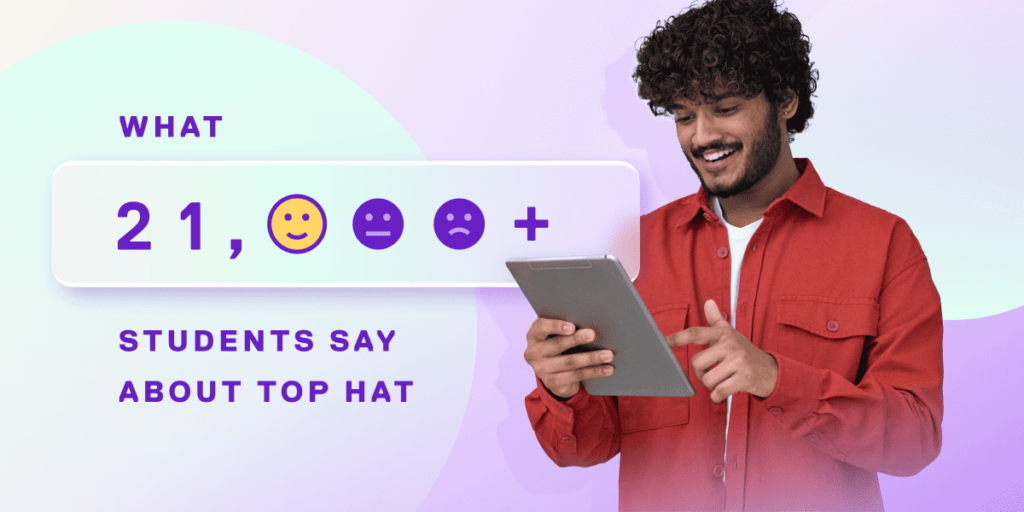Blank stares. Eyes focused on cell phones. A lack of participation. For instructors, it’s clear when students are not engaged during class. But why is student engagement so important?
In an era where technology permeates virtually every aspect of our lives, distractions are an ever-present concern. And this means that engagement strategies for students are becoming even more essential in modern college courses. So how do instructors build learning environments that are engaging, lively and motivated? They have to incorporate strategies to build community, connection and a love of learning.
Engaged students are typically more curious about a subject—perhaps even more passionate about it. Increasing engagement can help improve student motivation and, in turn, boost student progress and achievement as well.
Here, we provide 31 strategies to bring creativity, collaboration and participation to your classroom.
How student engagement strategies can fit in your classroom
In a classroom where engagement is emphasized, students are asked to participate more rigorously in the learning process and sometimes even in course design. Lectures still exist, but they now incorporate multimedia, technology and class participation. In hybrid and online learning environments, this can mean polling, classwide discussions and competitive activities. These engaging, relevant activities for students can energize your classroom and take learning to a new level, wherever it takes place.
By engaging in hands-on activities, students learn to support, trust and listen to each other, while developing important skills like collaboration and communication—skills that can’t be learned from a textbook, interactive or not. Learning to get along with peers, for example, isn’t something you can pick up through memorization.
Student engagement is closely linked to student achievement. Numerous studies have found that when instructors use strategies that are explicitly designed to get students’ attention—and to actively engage them in the learning process—test scores and graduation rates increase, and learning objectives are more likely to be met, which makes understanding how to engage students even more important for instructors.
What are student engagement strategies?
Student engagement strategies are activities, tactics and approaches educators can leverage during and after class to keep students invested in their learning. They can be used to increase active learning, participation and collaboration in the classroom—and can be everything from simple changes made in your next class to a complete revamp of your curriculum, course delivery and assessment methodology. Here are some creative strategies for engaging students in learning—ranging from small changes to more substantial pedagogical shifts.
Student engagement strategies for your teaching
1. Active learning:
Create a teaching and learning environment primed for student participation, such as calling on students to answer a question, individual reflection and group problem-solving.
Use case: Donna Smith, Instructor of Mathematics at Sierra College, used Top Hat to create a connected, engaging learning experience for students learning asynchronously. Leveraging Top Hat’s streamlined platform with features to customize course content, Smith uses more than 14 different question types to assess student learning as the course progresses. This fall, she plans to embed interactive questions between lecture videos, so students have the opportunity to practice course concepts right after learning them. “I love that we have that flexibility with the anonymous question,” Smith says. “In my class, 30 percent of my students are first-generation college students. And so for them to be able to ask a question without feeling judged or embarrassed is great.”
2. Participatory teaching:
This student-centered approach to pedagogy accounts for the different skills, backgrounds and learning styles of students. The focus of participatory teaching is on self-regulation and self-reflection; specific strategies include using different teaching methods and varying means of assessment, which adds a greater level of flexibility, a key part of any engagement strategies for online learning.
3. Flip the classroom:
Flip the traditional lecture-homework relationship. Students study the subject matter independently and outside class through tools such as pre-recorded videos. Class is then spent on student-centered learning such as working through problems, debating or group work.
4. Technology in the classroom:
Students expect to be constantly connected and want immediate feedback. Online and mobile technology can be used to provide active learning activities and to keep students engaged outside the classroom.
5. Classroom management strategies:
Classroom strategies help instructors build a distraction-free environment. As an instructor, you can build in student engagement by asking learners to help shape classroom rules. As an activity in the first week of classes, decide on a set of shared values and create a set of guidelines, like active listening, what respectful disagreements look like and how to create a safe space for questions.
5. Writing:
Exercises such as journaling and one-minute papers can help keep students engaged in class as well as improve thinking skills.
6. Culturally responsive teaching:
This strategy ensures students see themselves reflected in course readings, activities and lesson plans. Faculty might bring in diverse guest speakers to give a lecture on a niche topic. Alternatively, educators might ensure a certain percentage of their required readings are authored by scholars from under-represented populations.

Student engagement activities based on your curriculum
7. Set expectations:
At the beginning of a course, ask students what they expect from you and then try to meet those expectations. Students are more engaged when they have a good relationship with the instructor.
8. Integrated curriculum:
Combine disciplines rather than compartmentalizing subjects. Some medical schools, for example, have moved away from teaching subjects in isolation such as physiology and anatomy, and moved toward studying organ systems where students learn the physiology and anatomy associated with that system.
Use case: John Redden, Associate Professor of Physiology and Neurobiology at the University of Connecticut, is a long-time Top Hat user and has leveraged the platform to offer a consistent and equitable hybrid learning experience. “To me, that means giving students as much control over their own schedules as I possibly can,” Redden said. “It means trying to diversify the way that I teach and the ways that I assess student learning.” Redden noted that it’s important for students to work together in online learning environments. “We’re fortunate that many anatomy labs can be taught online because there are such great multimedia resources embedded right in our Top Hat textbook.”
9. Think-pair-share:
Think-pair-share encourages students to work together to solve problems. Students take a few moments of individual reflection to gather their thoughts on a given topic. Then, have them discuss their thoughts with a peer. Next, have the pair of students form a group with another pair and encourage the group of four to inquire about one another’s opinions.
Download Now: The Best Classroom Activities for College Classes [Free]
10. Make the course relevant:
Students want courses to be relevant and meaningful. Use real-world examples to teach; where the course is relevant to a specific occupation, ensure it’s aligned with the current needs of the occupation.
11. Cooperative learning:
How to increase student engagement? Encourage students to work together by arranging them in partners or small groups to help them achieve learning goals. Group work can include assignments, discussions, reviews and lab experiments—even having students discuss a lesson with their peers.
12. Authentic learning experiences:
Encourage active engagement in the classroom by having students tackle real-world problems and attempt to come up with a solution through methods such as inquiry and experimentation. Ideally, the solution will benefit others or the community. Experiential learning—when students learn from reflecting on their real-world learning experience—is a further development of this, and is an effective teaching strategy.
13. Social media:
Potential uses for social media include sharing relevant content, posting instructional videos on YouTube and facilitating ongoing discussion groups. However, strict guidelines for use must be put in place and enforced.
14. Quick writes:
During each lesson, ask students to write down their questions, thoughts and points of clarification. This is an easy-to-implement way to encourage students to think critically and analytically about the course content.
Student engagement strategies for assessments
15. Prepare for class before class:
Students get more out of class time if they’re familiar with the material before they arrive. Exercises such as pre-class quizzes ensure they’re knowledgeable enough to contribute.
16. Assess early and often:
Frequent quizzes for formative assessment (for “fun”) work well alongside traditional midterm and final exams. Frequent testing reduces the temptation for students to cram and forces them to space out their learning, which leads to better retention. Having the first test within the first few classes also helps prevent students from falling behind—boosting student achievement early.
17. Assess attendance:
Student attendance can improve grades as well as engagement. Consider making attendance part of their overall assessment. Many learners enter university without proper study skills, and first-year students can benefit from the structure of mandatory attendance.
18. Problem-based/project-based learning:
Students are tasked with solving a problem or completing a project, but the focus is on the end product, allowing students to determine what resources are needed to solve the problem or complete the project.
Classroom engagement strategies using your presentation skills
19. Use visual representations:
Engage students with animations, 3D representations and concept maps, all of which can help them visualize complex subjects.
20. Inquiry-based learning:
To answer questions posed by the instructor or by the students themselves, a learner undertakes his or her own research to arrive at an answer. Inquiry-based learning can be as simple as watching video lectures, or more involvement could come from designing and performing an experiment.
21. Use simulations:
Games or role-playing place students in an imaginary setting defined by the instructor, providing for an interactive, participatory learning experience.
22. Tell stories:
Wherever possible, tell stories to illustrate concepts when giving lectures. This helps students to process course concepts in their own words, and move past rote memorization. For example, you might ask them to paraphrase a story or definition, explain a concept in their own words, tell a story that relates to it, or provide analogies to further illustrate a course concept.
Use case: Steve Joordens, Professor of Psychology at the University of Toronto, has devoted much of his career to the issue of student distraction and its ephemeral counterpart, student engagement. And if he’s learned one thing about engagement, it’s that there’s more than one way to foster it. So he set about trying to name the different techniques, which led Joordens to create o develop a taxonomy of student engagement, complete with its own handy label: RIFS, an acronym for “Relevant, Interesting, Fun, Social.”
The taxonomy breaks down like so:
- Relevant is about answering the well-worn student grouse, “Why are we learning this?” Classroom activities such as problem-based or work-integrated learning can enhance any course material’s relevance.
- Interesting speaks to students’ intrinsic motivations: if they’re not learning something to accomplish a goal or use it in their daily life, they’re learning it because they’re interested. Personalized learning strategies in the classroom encourage students to take greater ownership over their own education, which develops a stronger sense of intrinsic motivation: it reinforces the fact that they’re not learning something because someone says they have to, but because they chose to.
- Fun is about making the classroom experience enjoyable, and Joordens turns to physiology to underline its importance. “When people feel anxious or stressed or under pressure, blood leaves the frontal lobe and people go into fight-or-flight mode,” he explains. “The reciprocal of that is to do things that make people feel comfortable and feel good about the class” to keep their minds relaxed and open.
- Social is about encouraging students to interact and learn from each other as well as from their instructors or their readings. Studies have shown that learning is most effective when the sense of community in a classroom is high. Tactics such as response systems and peer assessments foster more social interaction in learning.
Student engagement strategies to encourage collaboration
21. Snowball discussions:
Randomly assign students in pairs with a discussion question. After a few minutes, combine the pairs to form groups of four. After another five minutes, combine groups of four to form a group of eight—and so on. Continue combining groups until the class is back together.
22. Philosophical chairs:
Read a statement that has two possible answers —agree or disagree—out loud to your class. Ask students to move to one side of the room or the other, depending on whether they agree or disagree with the statement. Once all participants have selected a side, encourage students on either side to argue in favor of their position. This way, students can visualize where their peers’ opinions lie, compared to their own.
23. Affinity mapping:
Place students in small groups and pose a general question or problem to them that has many possible answers, such as “How would the history of the United States be different without Teddy Roosevelt” or “How would society be different if the Internet was never invented?” Then, have students write their ideas on small index cards or on an online discussion thread. After ten minutes, ask students to group their similar ideas into categories, then label the different groupings and discuss how each idea fits. You can also suggest that students consider how the categories are related. This allows students to participate in critical thinking by analyzing ideas and organizing them in relation to one another.

24. Concentric circles:
Ask students to form two circles: an inner circle and an outer circle. Each student on the inside is paired with a student on the outside. Have them sit facing each other. Pose a question to the broader group and ask the pairs to discuss their responses. Have students on the outside circle move one space over after five minutes so they’re standing in front of a different peer. Repeat the process for a few rounds, asking a new question each time and exposing students to their peers’ different perspectives.
25. Make it personal:
After a lecture unit or lesson concludes, arrange learners into discussion groups or online breakout rooms. To encourage students to reflect on their personal connections to the material they are learning, ask them questions like “How did this change your initial understanding of the concept” or “Describe your initial reaction to this idea.”
26. Socratic seminar:
To prepare for a discussion, ask students to review a textbook chapter or a separate reading and develop higher-order thinking questions to pose to their peers. During class, ask an open-ended question to introduce the activity. Then, have students continue the conversation, encouraging their peers to use evidence-based claims, based on course concepts or texts. Students are encouraged to share the floor with their peers, however, there doesn’t need to be a specific order for speaking.
Student engagement strategies to build communication skills
27. Brainwriting:
To build rapport and respect in your classroom, give students time to reflect on their learnings in writing, following a challenging course concept. Using guided prompts or leaving it open to your students’ interpretation, have them share their thoughts and questions in a conversation with peers during class time or through an online discussion thread. Knowing how to keep students engaged throughout the duration of class ensures that they will be able to understand course concepts on a deeper level.
28. Concept mapping:
Collaborative concept mapping is a way of visually organizing concepts and ideas, in order to better understand how they are related. This is a great way for students to gain a better understanding of others’ experiences and perspectives. In small groups, students can use this exercise to go over past work or to brainstorm ideas for future assignments and projects. For face-to-face classes, have students place sticky notes and chart paper on the classroom walls. For online classes, the digital whiteboard feature in Zoom allows students to map out ideas and connect concepts.
29. Debate:
Pose an issue or topic to your class. Then, place students into groups according to the position they hold on the topic. Ask each group to develop some arguments or examples to support their opinion. Next, put each group’s idea on a virtual whiteboard or piece of chart paper, to be a starting point for a classwide discussion. To conclude, encourage students to debate the strengths and weaknesses of each group’s argument, to help students improve their higher-order thinking and analysis skills.
30. Compare and contrast:
Place students into groups and ask them to focus on a specific chapter in their textbook. Encourage them to find similarities and differences between ideas that can be found in course readings and external sources, like articles and videos they may find. This way, students benefit from sharing resources and learning from one another’s perspectives.
31. Assess/diagnose/act:
This activity helps strengthen students’ problem-solving abilities and can spur more dynamic discussions. Propose a topic or controversial statement, then follow the steps below to start a discussion.
- Assessment: What is the main problem or issue?
- Diagnosis: What is its’ root cause?
- Action: How can we, as a group, solve the issue?
References
- Ojalvo, H. E., & Doyne, S. Five Ways to Flip Your Classroom With The New York Times. [Blog post] New York Times. Retrieved May 15, 2019 from https://learning.blogs.nytimes.com/2011/12/08/five-ways-to-flip-your-classroom-with-the-new-york-times/
- Evans, C., Muijs, D. & Tomlinson, M. (2015). Engaged student learning: high-impact strategies to enhance student achievement. [White paper] Retrieved May 15, 2019 from: https://www.heacademy.ac.uk/knowledge-hub/engaged-student-learning-high-impact-strategies-enhance-student-achievement
- Twelve Best Practices for Student Engagement and Retention. [White paper] Retrieved May 15, 2019 from Mansfield University of Pennsylvania: https://www.mansfield.edu/academic-affairs/upload/Twelve-Best-Practices-for-Student-Engagement-and-Retention-2012.pdf
- Quevillon, K. (2017). Student Attendance Matters, Even If Lectures Are Online. Ask Harvard. [Blog post] Retrieved May 15, 2019 from Top Hat Blog: https://tophat.com/blog/student-attendance-harvard/
- Inquiry-Based Learning. Retrieved May 15, 2019 from Queens’ University, Kingston: https://www.queensu.ca/ctl/teaching-support/instructional-strategies/inquiry-based-learning
Related pages
Learn more about Top Hat’s student engagement software.


